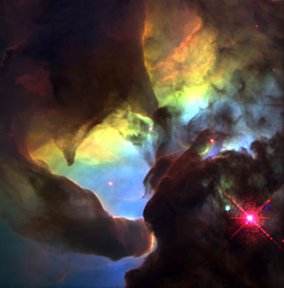There's a kind of a hush all over the world.
 Sadness all over again. The agony of another world war. Tears
and sorrow. One would say that it was with a weary pen that ERB wrote
the tale of dreary events to come were it not for the fact that he claimed
that the story was transmitted across the eons from the farthest star as
his typewriter keys began mysteriously clacking by themselves. One
almost believes him as the story was completed in only eleven days from
10/24 to 11/05 in 1940.
Sadness all over again. The agony of another world war. Tears
and sorrow. One would say that it was with a weary pen that ERB wrote
the tale of dreary events to come were it not for the fact that he claimed
that the story was transmitted across the eons from the farthest star as
his typewriter keys began mysteriously clacking by themselves. One
almost believes him as the story was completed in only eleven days from
10/24 to 11/05 in 1940.
It must have been with
some fear and trepidation that his generation faced the horrifying repeat
of 1914-18 in 1940. In that earlier conflict ERB expressed his thoughts
in an equally short novel titled Beyond Thirty. As a result
of the Great War he forecast an abandoned England, a Europe invaded by
Africa and turned Negroid, an Eastern empire ruled by a beneficent China
and the New World of North and South America governed benignly and peaceably
by the United States.
Faced with the grim reality
of possible total destruction from the air he now drew a much more dismal
picture. His old rival H.G. Wells in The Shape Of Things To Come
was even more desolated. Burroughs’ agent of destruction was
accurately projected. It was the great air fleets of, as it turned
out, B-29 bombers that flattened whatever they flew over.
"Planes!" said Yamoda's
mother bitterly, "Planes! The curse of the world. History tells us
that when they were first perfected and men first flew in the air over
Poloda, there was great rejoicing, and the men who perfected them were
heaped with honors. They were to bring the peoples of the world closer
together. They were to break down international barriers of fear
and suspicion. They were to revolutionize society by bringing all
people together, to make a better and happier world in which to live.
Through them civilization was to be advanced hundreds of years; and what
have they done? They have blasted civilization from nine tenths of
Poloda and stopped its advance in the other tenth. They have destroyed
a hundred thousand cities and millions of people, and they have driven
those who have survived underground, to live the lives of burrowing rodents.
Planes! The curse of all times, I hate them. They have taken
thirteen of my sons and now they have taken my daughter.
So ERB projects
a view of planes and that was before the B-2 bomber was constructed or
the A-bomb perfected. At that dim far off time at the beginning of
the twentieth century when the Wrights flew the first heavier-than-air
craft the hope was that it would eliminate war but now forty years later
after a rapid series of improvements the airplane was the ultimate weapon
of destruction. Of course both Burroughs and Wells had foreseen such
a development. Burroughs in his great Martian air fleets and Wells
in his sky darkening flotillas in The War In The Air.
The great B-29 fleets
were already being discussed so that Burroughs merely projected what within
a few short months would be a reality in Frankfurt when bombs and incendiary
devices rained down creating a fire storm with such intense heat that hydrogen
and oxygen molecules in the river separated with the inflammable hydrogen
being fed by the oxygen.
Forty-three thousand
people -- men women and children -- died in that fire storm that devastated
several square miles creating winds of 150 miles per hour.
The devastation was unequaled until the atomic bomb exploded over Hiroshima.
The level of destruction was almost equal in each.
It was almost as though
Burroughs had the image of the firestorm before his eyes as he wrote.
As the scene of this
great air war that had been fought non-stop for over a hundred years he
selected the planet Poloda part of the stellar system beyond the farthest
star indicating that war was so endemic to humans that even beyond
the farthest star there was no escaping it.
At that time Burroughs
placed the farthest star 450,000 light years from earth. One is astonished
at the low level of astronomical knowledge of the times. The truer
figure for a farthest star would be well over 12 billion light years but
that would have been incomprehensible at the time. One is startled
to think that the vast knowledge, still a fragment, we now possess was
unknown even as the fifties began when I was a child. Everything
I learned in school was invalidated by the time I graduated. The
novel geologic idea of tectonic plates whereby all the continents had been
connected and drifted apart was ridiculed while I was in college in the
mid-sixties but shortly prevailed. Astronomical horizons were pushed
further out as everything that was believed to be true was transfigured
before your eyes, nearly on a daily basis. Today the Hubble telescope
penetrates space as far as it has even been penetrated yet has still to
find the farthest star. Burroughs' farthest star was pretty close.
At any rate it made a great title.

In many ways Burroughs'
description of the two competing political systems on Poloda, those of
Unis/Athens and Kapara/Sparta more anticipated the post-war struggle between
the West and the Communist East rather than the Nazis and the West even
though the Kapars seem to be clearly based on the Nazis. Burroughs
old hatred of Germans stemming from the days of athe Haymarket Riot in
Chicago through the Great War was now reactivated and cast in concrete.
The war on Poloda mirrored
the reality on earth projected into a distant galaxy. Nor was ERB
wrong as WWII morphed into the Korean War and from thence into Viet Nam
and now into the great conflict with the Moslem States. We're not
too far from the centenary of the beginning of the Great War -- a full
hundred years.
On Poloda as a result
of the constant bombing raids from Kapara the Unisans had created retractable
cities. When the air raid sirens went off whole cities were hydraulically
lowered beneath the earth until the raid was over. Then the cities
were elevated while work crews went out to reconstruct the terrain into
livable space again.
In Kapara, somewhat like
in North Korea during the incessant bombing of the Korean War, the
Kapars had tunneled into their mountains in steel reinforced redoubts.
The Kapars had subjugated
a race somewhat as the Spartans had the Messenians who had returned to
the lowest subsistence level actually having reverted to cannibalism.
While thus portraying
life on Poloda ERB was giving intimations of his fears for his own planet.
The devastation of the ensuing war was not quite so complete but it came
very, very close.
Of ERB's wide ranging
interests astronomy was one. As I indicated earlier the level of
astronomical knowledge in the first half of the twentieth century was fairly
primitive. At the time man first walked on the moon in the sixties
outer space was still largely a mystery. It is only since then with
the huge arrays of radio telescopes on earth and the Hubble stationed in
space above the earth that some of the mysteries of the universe are becoming
more clear; even then compared to what there is to be known little is that
clear.

Thus ERB imagined a solar
system in which a ring of eleven planets circled a smaller sun from a distance
of a million miles through an atmospheric tube shared by all eleven planets.
The pollution from the incessant warfare on Poloda would be shared by all
eleven planets in the tubular atmosphere returning back on Poloda.
Titillating stuff.
ERB was always inventive.
I, of course, scoffed
at the idea of more than one planet being in the same orbital plane but
then all my notions of regularity and order were blasted when the Hubble
found two gas giants close to each other on the same orbital plane, close
to their sun, completing a revolution in three days. A three day
year, think of it, something a million of their light years away would
be right next door.
I imagine ERB would be
having a field day if he were still alive.
~ RE Prindle - February 26, 2010





